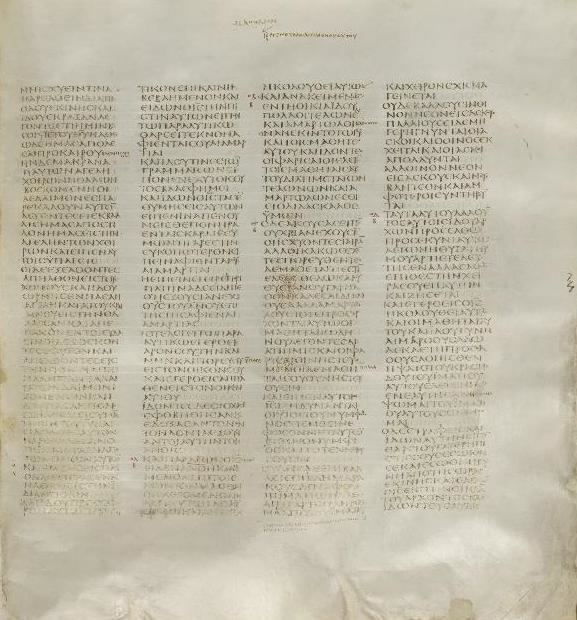Order in the Bible part 1 | Category Gospel | |
 | ||
Matthew 9 is the ninth chapter of the Gospel of Matthew in the New Testament and continues the narrative about Jesus' ministry in Galilee as he ministers to the public, working miracles, and going through all the cities and towns of the area, preaching the gospel, and healing every disease.
Contents
Text
Structure
This chapter can be grouped (with cross references to parallel texts in Mark and Luke):
Pharisees
This chapter develops Matthew's account of the hostility which the Pharisees, (one of the sects of Second Temple Judaism), showed towards Jesus and his disciples. Following the calling of Matthew, Jesus and his disciples are invited to eat in the house (Matthew 9:13 - this is often understood to refer to Matthew's house, because in Luke 5:28 the house is clearly that of Matthew known also as Levi) and "many tax collectors and sinners came and sat down with Him and His disciples". The Pharisees in all three synoptic gospels ask the disciples why Jesus eats with tax collectors and sinners ("such scum" in the New Living Translation) and the question is either relayed back to Jesus or he overhears it. Jesus' reply comes in three parts:
The words to repentance are "of doubtful authority here, and more than doubtful authority in Mark 2:17; but in Luke 5:32 they are undisputed".
Fasting
Verse 14 aligns both the disciples of John the Baptist and the Pharisees in the practice of regular fasting, and contrasts this with the practice of Jesus' disciples, who appear not to fast. In Matthew's gospel it is John's disciples who ask the question, for themselves and for the Pharisees, about why Jesus' disciples do not fast. In Mark's gospel, the question is in some interpretations asked by apparently impartial observers - "some people came and asked Jesus ...".
Raising of Jairus' Daughter and Healing of the Bleeding Woman
In the Gospel of Luke, the miracles follow the exorcism at Gerasa. Back in Galilee, Jairus, a patron or ruler of a Galilee synagogue, had asked Jesus to heal his 12-year-old daughter, who was dying (in Matthew's account, Jairus used hyperbolic expressions in his anxiety: ‘My daughter is even now dead’). As they were travelling to Jairus' house, a sick woman in the crowd touched the border (or possibly the fringe) of Jesus' cloak and was healed of her sickness. Jairus' daughter was then reported as having died, and Jairus was therefore advised not to trouble Jesus, 'the teacher', any further. Jesus, however, continued to the house, stating that the girl was not dead but asleep, and restored her to health. The chapter ends with Jesus' mandate that Jairus and his wife should tell no-one what had happened.
Tzitzit
Matthew's (and Luke's) accounts specify that the bleeding woman touched the "fringe" of his cloak, using a Greek word kraspedon which also appears in Mark 6. According to the Catholic Encyclopedia article on fringes in scripture, the Pharisees, who were the progenitors of modern Rabbinic Judaism, were in the habit of wearing extra-long fringes or tassels (Matthew 23:5), a reference to the formative çîçîth (tzitzit). Because of the Pharisees' authority, people regarded the fringe with a mystical quality.
Jesus' compassion
The chapter concludes with a summary of Jesus' ministry "in all the cities and villages". When he saw the crowds he was moved with compassion for them, seeing the crowds as "sheep without a shepherd". According to the Westcott-Hort Greek New Testament, the crowds were Greek: ἐσκυλμένοι καὶ ἐριμμένοι, eskylmenoi and erimmenoi, but in the Textus Receptus the first adjective here is Greek: ἐκλελυμένοι, eklelymenoi. According to Bengel's Gnomon, "the reading ἐκλελυμένοι is clearly deficient in authority".
English translations vary widely in how they translate these two adjectives:
The portrayal of "sheep without a shepherd" reflects Moses' prayer for God to appoint a leader to succeed him after his death during the Israelites' Exodus journey:
Moses spoke to the Lord, saying: 'Let the Lord, the God of the spirits of all flesh, set a man over the congregation, who may go out before them and go in before them, who may lead them out and bring them in, that the congregation of the Lord may not be like sheep which have no shepherd'.